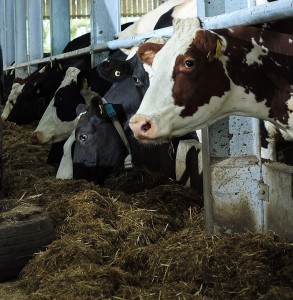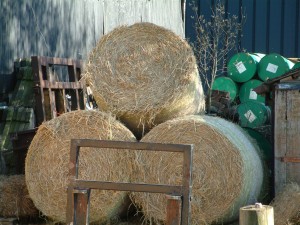Cattle Diseases
Abomasal Displacement in Cattle
Also known as: Displaced Abomasum, LDA and RDA
What is abomasal displacement?
Control and Prevention
Treatment Options
What about Welfare?
Good Practice
Whilst the aetiology of abomasal displacement is not clearly established and is probably of a multiple nature, mainly associated with reduced feed intake, abomasal gas production and abomasal atony, the following risk factors have been identified:
- high yielding cows (Ricken et al., 2004),
- intensive concentrate feeding,
- late gestation or early lactation,
- changes in weather conditions ( da Silva et al., 2004),
- significant body condition score loss in the periparturient period (Kim and Suh, 2003),
- association with milk fever and poor dry cow management with insufficient long fibre in the diet
- no introduction to lactation period feeding before calving (Grymer et al., 1981; Constable et al., 1992; Rohrbach et al., 1999).
In Scandinavia, an association with high levels of root crops in the diet has also been made, particularly with RDA. It is believed that the soil on the root crops is the initial factor, causing ulceration of the stomach, leading to abomasal atony and displacement. An association with forestomach disorders, particularly foreign bodies (i.e. small fragments of wire) in the rumen-reticulum, has been reported as well (Yamada, 1982).
| Individual Animal Factors | Management / Herd Factors |
|---|---|
| Breed, sex, age, milk yield (although this could be indirect effect of nutrition), over-fat body condition at calving
Intercurrent diseases:
Parturition related problems:
|
Nutrition:
Poor feeding practices:
Season – probably reflects management and forage quality rather than a true seasonal effect |
TMR = total mixed ration; DMI = dry mater intake
(Table adapted from Barret, 2003).
Forage-based herds are less likely to experience problems with displaced abomasum, other than as sporadic cases secondary to milk fever or other diseases. Outbreaks associated with soil-contaminated root crop feeding are a possibility on farms where fodder beet is used in large quantities. However, one study indicated that herds that received fewer energy-rich carbohydrates in their diets than control herds experienced a higher incidence of displaced abomasum (Geishauser, 1996). Organic herds that have difficulties in meeting the energy requirements on home-grown diets immediately after calving might, therefore, be predisposed. Rumen acidosis can also occur on farms if structural fibre is lacking e.g., at turnout onto fresh grass.
Control and Prevention of Abomasal Displacement

Risks associated with abomasal displacement include intensive concentrate feeding, and not enough long fibre in the diet.
In cases of sporadic occurrence of abomasal displacement in a single cow, there is usually no need to change the existing feeding or management system. An isolated case is most likely to be of a secondary nature, due to milk fever, metritis or another disease that causes abomasal atony.
However, if one or several cases are diagnosed during consecutive housing periods, there is a need to investigate the potential causes of this, and improve feeding or management as needed.
The following measures have been recommended:
- Provision of adequate long fibre in dry cow diet (preferably hay)
- Provision of an adequate supply of palatable energy-rich carbohydrates in the diet, particularly immediately after calving
- Provision of adequate daily exercise for dry cows
- Gradual introduction of concentrates in the dry cow diet prior to calving (up to 2 kg /cow) but avoidance of “steaming up”
- Limited amount of maize silage to dry cows
- Avoidance of “peaking” the milk production in early lactation by increasing concentrate intake
- Prevention of hypocalcaemia and ketosis in the periparturient period
- Achieving the optimum body condition score at dry-off (2.5/5) and calving (2.5-3/5), to minimise condition score loss in the periparturient period to a maximum of 0.5 score (1-5 score).
Treating Abomasal Displacements
Once the diagnosis of displaced abomasum has been established, it is important to treat it as early as possible to avoid stomach ulceration and complications caused by associated secondary acetonaemia / ketosis.
Early surgical treatment with well-balanced fluid therapy is recommended as carrying a better prognosis (Rohn et al, 2004), but in some cases the condition may be relieved by rolling and exercise. Before undertaking surgical correction, a thorough clinical examination should be performed by a vet to establish any other underlying disease and to enable a better estimate of the prognosis. In spite of the high cost of surgical therapy, it should be attempted, as the prognosis is reasonable and the only alternative is slaughter (Petty, 1981; Varden, 1979; Vlaminck, 1996). Surgical treatment of LDA carries a better prognosis for recovery compared to RDA (Hamann et al, 2004).
Abomasal Displacement and Welfare
Abomasal displacement is potentially distressing, painful and life-threatening to cattle, and should be prevented by good feeding and management of housed cows during dry period and early lactation. In an outbreak, every effort should be made to establish the cause of the disease and to correct management and feeding accordingly.
Sporadic cases should be treated by a veterinarian as soon as a diagnosis has been established. Surgical treatment should not be delayed if conservative therapy fails.
Cows with ketosis/acetonaemia that do not respond to normal treatment should be checked by a veterinarian to rule out the possibility of a secondary ketosis due to displaced abomasum or other causes like fatty liver.
Good Practice Based on Current Knowledge
On established low input farms with milk yields below 6500 kg and the forage part of the diet above 60% of the dry matter (DM) intake, abomasal displacement is an unlikely problem. Good practice in preventing abomasal diseases needs to concentrate on dry cow management and, where root crops are fed in large quantities, on ensuring that soil contamination of the fodder is not excessive.
- Specify measures for transition cow management in the herd health plan, preferably including advice from the farm’s veterinary surgeon
- Provide an adequate amount of long fibre forage – preferably hay – during the dry period and early lactation, and avoid large quantities of maize silage as the main forage
- Introduce concentrates gradually, starting two weeks before calving, up to 2 kg/cow by calving date
- Do not attempt to “steam up” the cows before calving or “peak” them after calving
- Provide an adequate amount of energy-rich carbohydrates immediately after calving
- If fodder beet is heavily soiled, wash it before including it in the diet
- If the farm has experienced recurring outbreaks or repeated sporadic cases during recent housing periods, it would be advisable to incorporate guidelines for prompt treatment and control into an Animal Health Plan including advice from the veterinary surgeon.
- Identification and exclusion of the predisposing feeding and management practices should be included in the conversion plan (Barrett, 2003).


 American English
American English


Comments are closed.